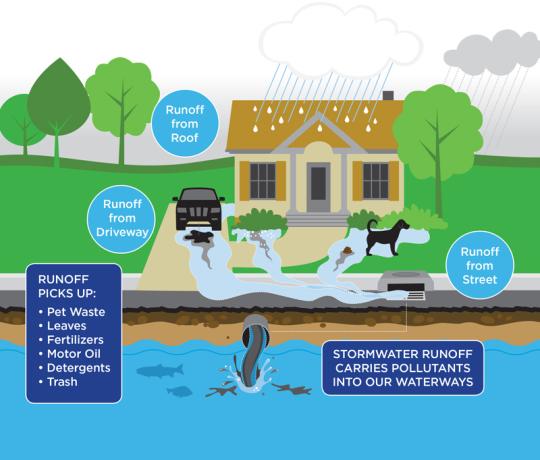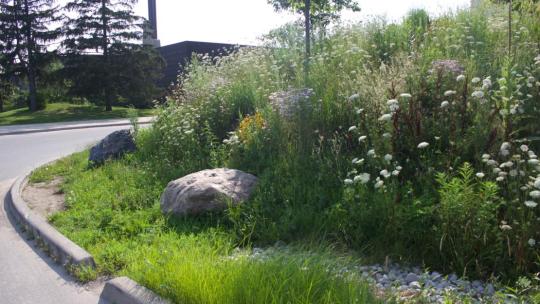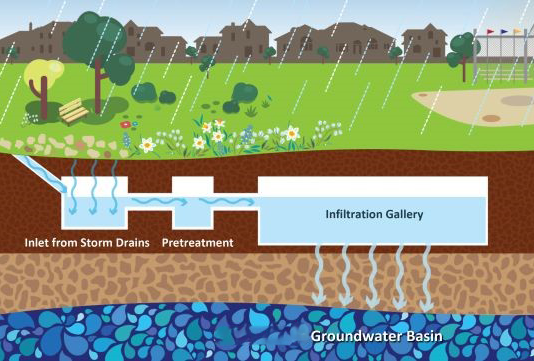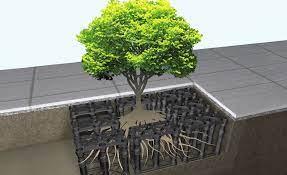
It is in the best interests of all members of the ecosystem—plant, animal, and human—to maximize the amount of rainwater that can successfully infiltrate our underground water table. In urban areas, such as U of T Scarborough Campus, this is done through effective stormwater management.

In normal circumstances, rainwater sinks into the ground through the soil, seeping into the underground water table, where it helps to stabilize the water levels of our rivers, streams and lakes. In urbanized areas, however, many areas are paved over with impermeable materials like asphalt, meaning that rainwater cannot pass through to saturate the ground below. In addition, urbanized areas also suffer from soil compaction, reducing the soil's ability to absorb rainwater.
As a result, rainwater in urban areas collects on the surface and flows into the city’s sewer system, across surfaces covered with oil, grease, metals, sand and other pollutants. This polluted water is then carried out into our rivers and lakes by our sewer systems. The high volume of rainwater unable to penetrate the ground moves fast, causing erosion in our streams and, in severe cases, flash flooding.
Luckily, there are many successful techniques and technologies which help us mitigate the impact of stormwater in our urban environments, ensuring our ability to replenish our water table, nourish the soil, reduce water pollution and prevent erosion and flooding.

UTSC employs a few different strategies to manage stormwater. Water infiltrates soil very slowly, so the goal of all stormwater infrastructure is to slow the flow of water as much as possible, giving rainwater time to infiltrate the soil rather than be swept into the sewer system.

South campus has inherited a stormwater system from the 1960s, which collects stormwater and directs it into the Highland Creek. There are two bioswales on south campus which help to reduce the amount of stormwater directed into this outdated system.
Bioswales are sloped channels which concentrate stormwater in one place, allowing it time to sink into the ground. These channels are filled with vegetation, which filters out pollutants by trapping it in the soil, where it decomposes or is broken down by natural bacteria.
Bioswales are especially useful in areas with high vehicle traffic and automotive pollution, which is why the bioswales on south campus are located in the bus loop and the pick-up/drop-off loop. Besides preventing water pollution, bioswales also add visual interest and provide habitat for wildlife.


North campus has been able to build stormwater infrastructure as new buildings have been constructed. Stormwater from the Instructional Centre, the Environmental Science Building and the site of the future Indigenous House gathers in a bioswale behind the Instructional Centre.
[diagram] [map]
This bioswale has been built on top of an engineered infiltration gallery. This gallery is an underground cavern built in cement with a gravel floor. Stormwater gathers and is stored in this cavern, but unlike a cistern, the gravel floor is a permeable surface that allows the stormwater to slowly infiltrate into the earth below.
This infiltration gallery has the capacity for a “100 year storm.” This means that even in the case of a historic, unusually heavy downpour, the gallery would not overflow into the city sewer system.

Other smaller features factor into the larger picture of stormwater management at UTSC, including permeable pavers. Tree islands are a distinct feature as well, often planted alongside parking lots or roads. These trees are planted in lattice-like structures that provide the tree support without having to compact the soil. The tree roots are able to grow through the lattice, and stormwater is able to gather and infiltrate the soil—nourishing the trees and preventing stormwater overflow.